1.1 The test methods described in this fire-test-response standard are used for determining the fire-test response of columns, girders, beams or similar structural members, and fire-containment walls, of either homogeneous or composite construction, that are employed in HPI or other facilities subject to large hydrocarbon pool fires.
1.2 It is the intent that tests conducted in accordance with these test methods will indicate whether structural members of assemblies, or fire-containment wall assemblies, will continue to perform their intended function during the period of fire exposure. These tests shall not be construed as having determined suitability for use after fire exposure.
1.3 These test methods prescribe a standard fire exposure for comparing the relative performance of different structural and fire-containment wall assemblies under controlled laboratory conditions. The application of these test results to predict the performance of actual assemblies when exposed to large pool fires requires a careful engineering evaluation.
1.4 These test methods provide for quantitative heat flux measurements during both the control calibration and the actual test. These heat flux measurements are being made to support the development of design fires and the use of fire safety engineering models to predict thermal exposure and material performance in a wide range of fire scenarios.
1.5 These test methods are useful for testing other items such as piping, electrical circuits in conduit, floors or decks, and cable trays. Testing of these types of items requires development of appropriate specimen details and end-point or failure criteria. Such failure criteria and test specimen descriptions are not provided in these test methods.
1.6 Limitations – These test methods do not provide the following:
1.6.1 Full information on the performance of assemblies constructed with components or of dimensions other than those tested.
1.6.2 An evaluation of the degree to which the assembly contributes to the fire hazard through the generation of smoke, toxic gases, or other products of combustion.
1.6.3 Simulation of fire behavior of joints or connections between structural elements such as beam-to-column connections.
1.6.4 Measurement of flame spread over the surface of the test assembly.
1.6.5 Procedures for measuring the test performance of other structural shapes (such as vessel skirts), equipment (such as electrical cables, motor-operated valves, etc.), or items subject to large hydrocarbon pool fires, other than those described in 1.1.
1.6.6 The erosive effect that the velocities or turbulence, or both, generated in large pool fires has on some fire protection materials.
1.6.7 Full information on the performance of assemblies at times less than 5 min because the rise time called out in Section 5 is longer than that of a real fire.
1.7 These test methods do not preclude the use of a real fire or any other method of evaluating the performance of structural members and assemblies in simulated fire conditions. Any test method that is demonstrated to comply with Section 5 is acceptable.
1.8 The values stated in inch-pound units are to be regarded as standard. The values given in parentheses are mathematical conversions to SI units that are provided for information only and are not considered standard.
1.9 This standard is used to measure and describe the response of materials, products, or assemblies to heat and flame under controlled conditions, but does not by itself incorporate all factors required for fire hazard or fire risk assessment of the materials, products, or assemblies under actual fire conditions.
1.10 This standard does not purport to address all of the safety concerns, if any, associated with its use. It is the responsibility of the user of this standard to establish appropriate safety and health practices and determine the applicability of regulatory limitations prior to use.
1.11 The text of this standard references notes and footnotes which provide explanatory information. These notes and footnotes (excluding those in tables and figures) shall not be considered as requirements of the standard.
Product Details
- Published:
- 09/01/2010
- Number of Pages:
- 24
- File Size:
- 1 file , 400 KB
- Redline File Size:
- 2 files , 700 KB


